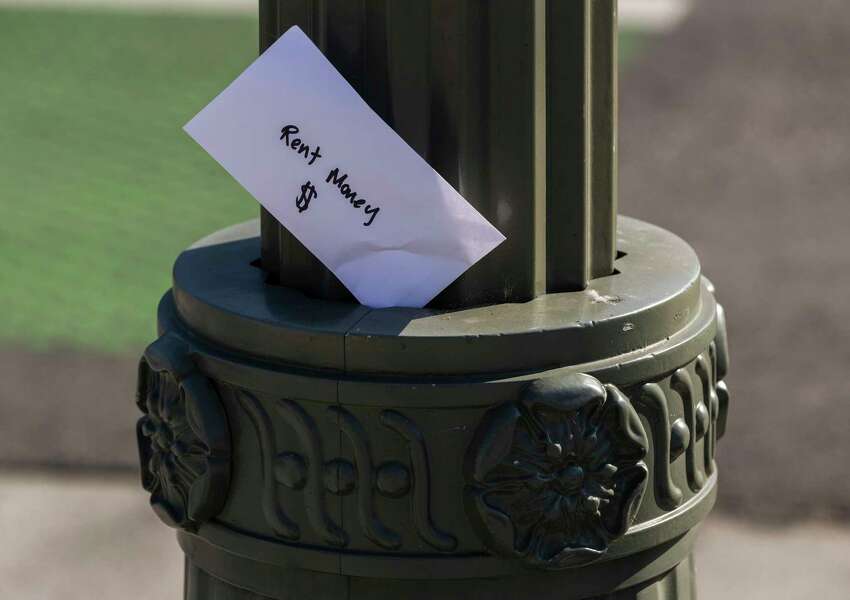
After Megan Pearson's job as a restaurant server was put on hold because of COVID-19 stay-at-home orders, the single mom had to figure out how to come up with the rent for her apartment in Brooklyn.
"I posted my frustration on Facebook with trying to get through to unemployment the first week," Pearson said. "I probably made 200 phone calls before I got it all settled."
Uncertain whether assistance would arrive on time or at all, Pearson created a crowdfunding account at the encouragement of a friend. This bought her time and ultimately allowed her to stay in her apartment without taking on expensive debt.
If you're scrambling to make rent, consider the following steps before resorting to high-interest loans.
Explore free options
Some states have banned evictions during the COVID-19 crisis, but you're still responsible for paying rent. The first step is to re-evaluate your budget and find money where you can.
Cut back on nonessential expenses, lower 401(k) contributions, reach out to creditors for assistance and seek low-income programs for food and utilities, said Jeffrey Arevalo, a financial wellness expert with nonprofit credit counseling agency GreenPath.
Other options that cost nothing or close to it:
Applying for unemployment or other assistance programs: Pearson expects she'll cover future rent payments with unemployment and coronavirus stimulus money.
Talk to your landlord: Ask for time until a check arrives. You could also request an installment plan or waived late fees. Your landlord might be willing to help, especially if you have a history of paying on time. Whatever terms are negotiated, get them in writing.
Call 211: Local nonprofits and religious organizations might offer assistance. United Way helps access those services upon calling 211.
Apply for grants in your industry: Pearson applied for a grant from the Restaurant Strong Fund, which helps restaurant workers affected by COVID-19 closures, though she has not yet heard back.
Ask for help from family or friends: Pearson raised $3,995 toward rent and essential expenses via the GoFundMe crowdfunding platform. "If you don't ask, no one knows you need it," Pearson said.
If your lease permits, consider subletting your apartment or a room: Or move in with a loved one and help each other by divvying up rent costs.
Seek professional advice: GreenPath Financial Wellness is offering free phone-based financial counseling during the pandemic.
Lean on investments
Typically, it isn't advisable to dip into money that's meant for your future, but these aren't typical times.
If you have a taxable brokerage account, consider selling stocks. Another option might be a withdrawal from a 401(k) or individual retirement account, said Andrew Rosen, financial adviser and partner at Diversified, a financial planning firm.
Under the Coronavirus Aid, Relief and Economic Security Act those younger than 59½ years impacted physically or financially by COVID-19 can withdraw up to $100,000 from an eligible 401(k) or IRA through Dec. 31, without the usual 10 percent early withdrawal penalty. The tax bill is spread over the next three years, and you can claim a tax refund if you pay it back before that time. If you've lost your job, roll over your 401(k) to an IRA and then make a withdrawal.
The CARES Act also lets qualifying 401(k) plan participants borrow their vested balance up to $100,000 as a loan. And in emergencies unrelated to COVID-19, a loan on a 401(k) avoids penalties, taxes and a credit check.
If you are drowning in debt and rent is just one of many financial obligations, you may consider other options.
"Most people don't realize that generally speaking, your retirement accounts are protected in a bankruptcy," Rosen said.
Choose the least expensive high-interest debt
Without sufficient income or good credit (typically a FICO score of at least 690), you may be left with only high-interest financing options. Consider the following, in order from least to most expensive:
Borrow against your existing credit card's limit. The Citi Flex Loan and My Chase Loan let you borrow against your card's credit limit with a fixed interest rate and term. The money is deposited into a bank account.
Pay rent with your credit card. Plastiq, for instance, will let you charge your rent to your card and will then cut your landlord a check on your behalf, in exchange for a 2.5 percent processing fee. Weigh the costs before going this route, and be aware that if you can't pay it back within a billing cycle, you'll incur interest on the rent payment at whatever APR your card charges.
As a last resort, consider a cash advance. This can offer quick cash up to the amount of your available limit, but you'll pay dearly with a steep fee and an interest rate that starts accruing the moment you pull the cash from your bank or ATM. Cash advances could also negatively impact your credit by increasing your credit utilization, a key factor in credit scores. Still, it's cheaper than a payday loan, which may not be an option anyway if you are no longer collecting a paycheck.
"pay" - Google News
May 23, 2020 at 08:05AM
https://ift.tt/2LUbmnM
How to pay the rent when you can't afford it - Albany Times Union
"pay" - Google News
https://ift.tt/301s6zB
Bagikan Berita Ini














0 Response to "How to pay the rent when you can't afford it - Albany Times Union"
Post a Comment